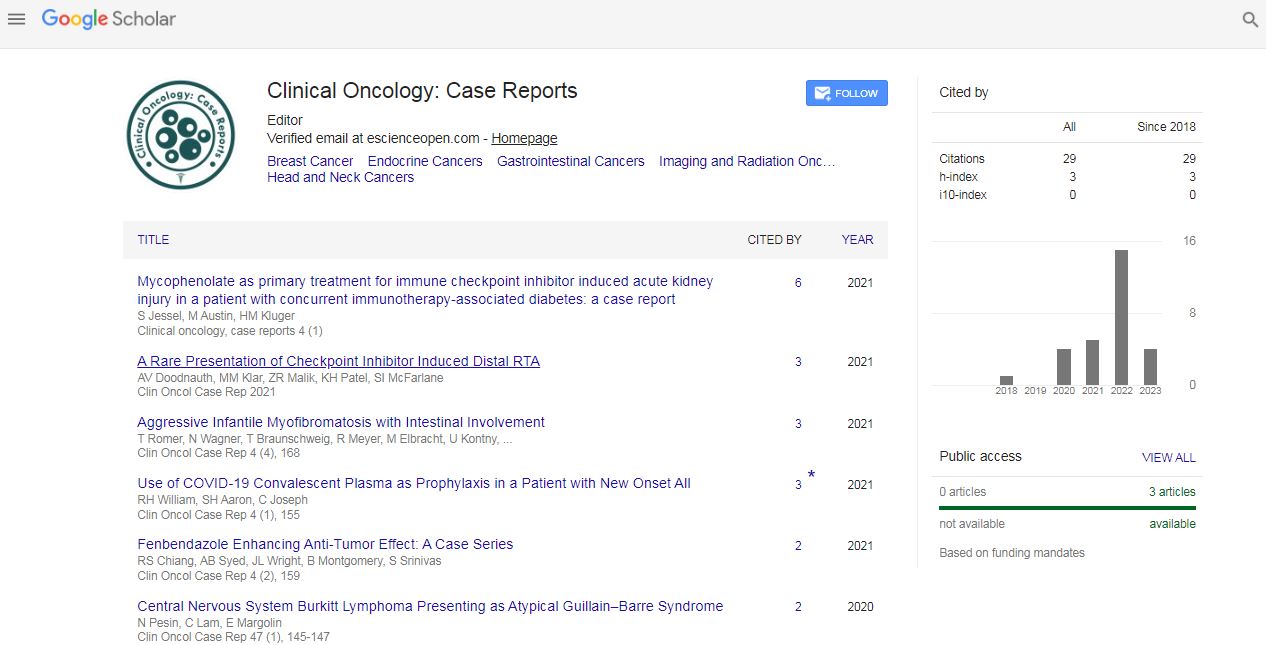Perspective, Cocr Vol: 7 Issue: 3
Unraveling the Complexities of Bladder Carcinoma: Understanding Pathogenesis, Diagnosis, and Treatment
Nick Aglo*
The Affiliated University of MD Anderson Cancer Center, Australia
*Corresponding Author: Nick Aglo
The Affiliated University of MD Anderson Cancer Center, Australia
E-mail: aglonck@hotmail.com
Received: March 11, 2024; Manuscript No: COCR-24-132681
Editor Assigned:
March 17, 2024; PreQC Id: COCR-24-132681 (PQ)
Reviewed: March 22, 2024;
QC No: COCR-24-132681 (Q)
Revised: March 27, 2024; Manuscript No: COCR-
24-132681 (R)
Published: March 30, 2024; DOI: 10.4173/cocr.7(3).342
Citation: Aglo N., (2024) Unraveling the Complexities of Bladder Carcinoma: Understanding Pathogenesis, Diagnosis, and Treatment Clin Oncol Case Rep 7:3
Abstract
Bladder carcinoma, a prevalent malignancy worldwide, poses significant challenges in its diagnosis and management. This article provides a comprehensive review of bladder carcinoma, encompassing its etiology, risk factors, molecular pathogenesis, diagnostic modalities, and therapeutic strategies. Understanding the intricate mechanisms underlying bladder carcinoma is crucial for the development of novel targeted therapies and improved patient outcomes.
Keywords: Bladder carcinoma; Bladder cancer; Urothelial carcinoma; Pathogenesis; Diagnosis; Treatment
Introduction
Bladder carcinoma, predominantly urothelial carcinoma, represents a substantial burden on global public health, ranking as one of the most common malignancies of the urinary tract. Despite advancements in diagnostic techniques and treatment modalities, bladder carcinoma continues to present challenges due to its heterogeneity, recurrence, and potential for progression to invasive disease. This article aims to elucidate the multifaceted aspects of bladder carcinoma, from its molecular underpinnings to clinical management strategies.
Etiology and Risk Factors
Bladder carcinoma arises from the epithelial lining of the urinary bladder, with the majority of cases being urothelial carcinoma. While the precise etiology remains elusive, several risk factors have been identified, including tobacco smoking, occupational exposure to carcinogens, chronic bladder inflammation, and genetic predisposition. Understanding these risk factors is imperative for preventive measures and early detection.
Molecular Pathogenesis
The molecular pathogenesis of bladder carcinoma involves complex interplay among genetic alterations, epigenetic modifications, and dysregulated signaling pathways. Key genetic aberrations implicated in bladder carcinoma include mutations in tumor suppressor genes (e.g., TP53, RB1) and oncogenes (e.g., FGFR3, HRAS), as well as alterations in cell cycle regulators and DNA repair mechanisms. Additionally, epigenetic alterations, such as DNA methylation and histone modifications, contribute to tumor initiation and progression. Insights into these molecular mechanisms offer potential targets for personalized therapeutic interventions.
Diagnosis and Staging
Accurate diagnosis and staging are essential for optimal management of bladder carcinoma. Diagnostic modalities include cystoscopy, urine cytology, and imaging studies such as Computed Tomography (CT) Urography and Magnetic Resonance Imaging (MRI). Furthermore, advances in molecular profiling and biomarker detection hold promise for enhancing diagnostic precision and prognostic stratification. Staging of bladder carcinoma is based on the Tumor, Node, Metastasis (TNM) classification system, which guides treatment decisions and prognostic assessment.
Treatment Modalities:
The management of bladder carcinoma depends on various factors, including disease stage, histological grade, and patient comorbidities. Treatment modalities encompass a multidisciplinary approach, including surgery, chemotherapy, radiation therapy, and immunotherapy. Transurethral Resection of Bladder Tumor (TURBT) remains the cornerstone of treatment for non-muscle-invasive disease, while radical cystectomy with urinary diversion is indicated for muscle-invasive or high-risk non-muscle-invasive disease. Additionally, the advent of immune checkpoint inhibitors, such as pembrolizumab and atezolizumab, has revolutionized the treatment landscape for advanced bladder carcinoma, offering durable responses and improved survival outcomes.
Future Perspective
Despite significant advances in the diagnosis and treatment of bladder carcinoma, several challenges persist, including the development of resistance to therapy and the identification of reliable predictive biomarkers. Future research endeavors should focus on unraveling the molecular heterogeneity of bladder carcinoma, exploring novel therapeutic targets, and refining personalized treatment approaches. Furthermore, efforts to integrate multimodal therapies and adopt precision medicine principles hold promise for optimizing patient care and mitigating disease recurrence.
Conclusion
Bladder carcinoma represents a formidable oncological challenge, necessitating a multifaceted approach encompassing molecular insights, advanced diagnostics, and tailored therapeutics. By elucidating the intricate mechanisms underlying bladder carcinoma and harnessing innovative treatment modalities, the medical community can strive towards improved patient outcomes and enhanced quality of life for individuals afflicted by this malignancy.
In summary, a comprehensive understanding of bladder carcinoma, from its etiology to therapeutic interventions, is imperative for addressing the evolving landscape of this disease and fostering progress towards more effective management strategies.
 Spanish
Spanish  Chinese
Chinese  Russian
Russian  German
German  French
French  Japanese
Japanese  Portuguese
Portuguese  Hindi
Hindi 